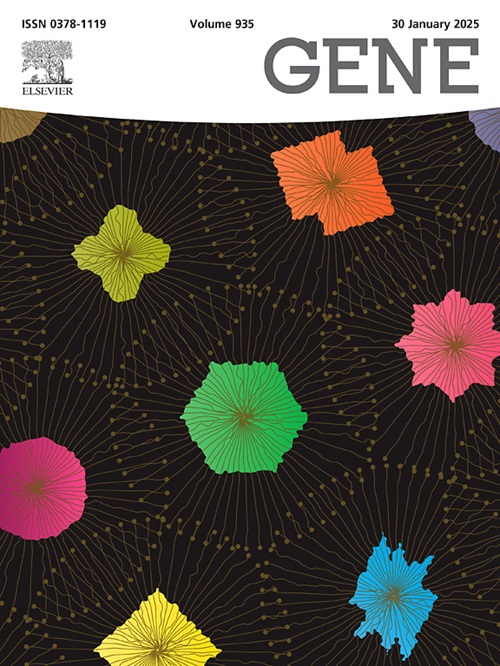Signatures of miRNA 5-methylcytosine modification profile and potential immune-related target gene regulation in diabetic kidney disease
IF 2.4
3区 生物学
Q2 GENETICS & HEREDITY
引用次数: 0
Abstract
Background
Diabetic kidney disease (DKD) is a major microvascular complication of diabetes, with microRNAs (miRNAs) playing a role in its pathogenesis through methylation modifications. Preliminary experiments indicated an association between 5-methylcytosine (m5C) modification and miRNA dysregulation in peripheral blood mononuclear cells (PBMCs) of DKD patients.
Methods
We employed Arraystar’s small RNA modification chip to detect m5C modifications in miRNAs from PBMCs of DKD patients and predicted target genes. Transcriptomic data were analyzed for immune infiltration, and weighted gene co-expression network analysis (WGCNA) was performed to identify key target genes. Validation was conducted using MeRIP-qPCR and quantitative real-time PCR.
Results
In DKD patients, 17 miRNAs showed elevated m5C levels, while 102 miRNAs exhibited reduced levels, associated with autophagy, pancreatic hormone signaling, and immune regulation. Immune infiltration analysis revealed significant differences in the infiltration of monocytes and eosinophils, correlating with classical immune pathways. Through WGCNA analysis of key monocyte modules, combined with target gene prediction, we identified TGFBR2 as a key target gene for the differentially m5C-modified miRNAs, potentially influencing immune infiltration in DKD. Further validation showed decreased m5C modification of miR-654-5p and elevated TGFBR2 expression in DKD, with a significant negative correlation. This relationship was further supported by qPCR analysis showing key methyltransferases (DNMT3B and NSUN2) expression inversely correlated with TGFBR2, suggesting m5C-mediated regulation.
Conclusions
Differential m5C modification of miRNAs may influence immune cell infiltration and contribute to the progression of DKD by modulating the expression of their target genes. TGFBR2 may serve as a target gene of miR-654-5p, regulated by its m5C modification status.

糖尿病肾病中miRNA 5-甲基胞嘧啶修饰谱和潜在免疫相关靶基因调控的特征
背景:糖尿病肾病(DKD)是糖尿病的主要微血管并发症,microRNAs (miRNAs)通过甲基化修饰在其发病机制中发挥作用。初步实验表明,DKD患者外周血单个核细胞(PBMCs)中5-甲基胞嘧啶(m5C)修饰与miRNA失调之间存在关联。方法:采用Arraystar公司的小RNA修饰芯片检测DKD患者外周血中mirna的m5C修饰,并预测靶基因。对转录组学数据进行免疫浸润分析,并进行加权基因共表达网络分析(WGCNA)以确定关键靶基因。采用MeRIP-qPCR和实时荧光定量PCR进行验证。结果:在DKD患者中,17种mirna的m5C水平升高,102种mirna的m5C水平降低,这与自噬、胰腺激素信号传导和免疫调节有关。免疫浸润分析显示单核细胞和嗜酸性粒细胞有显著差异,与经典免疫途径相关。通过对关键单核细胞模块的WGCNA分析,结合靶基因预测,我们发现TGFBR2是差异m5g修饰mirna的关键靶基因,可能影响DKD的免疫浸润。进一步验证表明,miR-654-5p的m5C修饰降低,DKD中TGFBR2表达升高,呈显著负相关。qPCR分析进一步支持了这一关系,显示DNMT3B/NSUN2表达与TGFBR2呈负相关,提示m5c介导的调控。结论:m5C差异修饰miRNAs可能通过调节靶基因的表达影响免疫细胞浸润,促进DKD的进展。TGFBR2可能作为miR-654-5p的靶基因,受其m5C修饰状态的调控。
本文章由计算机程序翻译,如有差异,请以英文原文为准。
求助全文
约1分钟内获得全文
求助全文
来源期刊

Gene
生物-遗传学
CiteScore
6.10
自引率
2.90%
发文量
718
审稿时长
42 days
期刊介绍:
Gene publishes papers that focus on the regulation, expression, function and evolution of genes in all biological contexts, including all prokaryotic and eukaryotic organisms, as well as viruses.
 求助内容:
求助内容: 应助结果提醒方式:
应助结果提醒方式:


